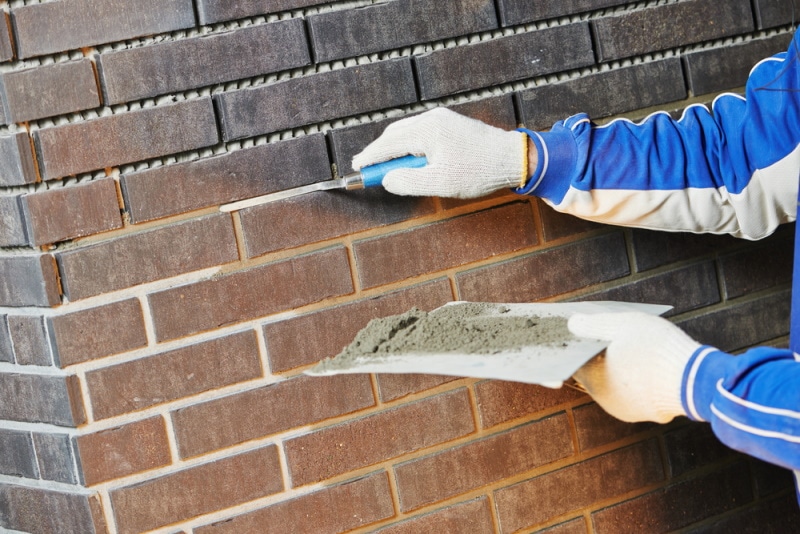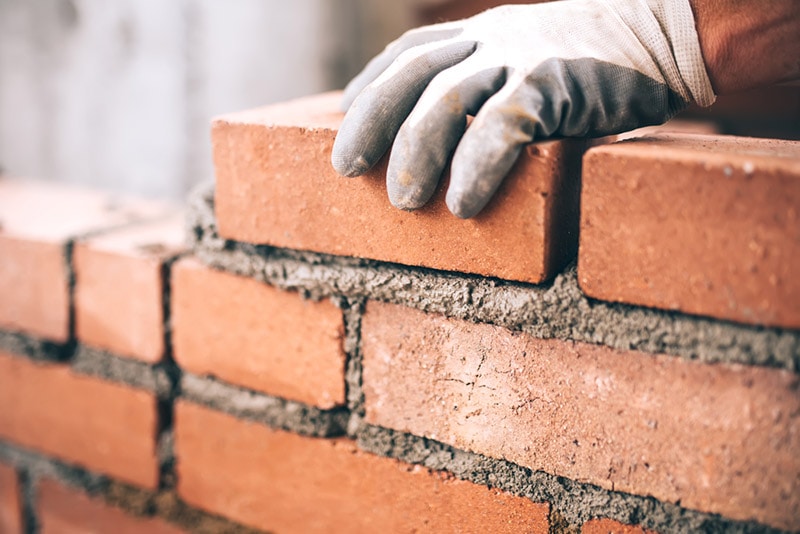8 Types of Mortar Joints (Pictures, Pros & Cons)
-
Ed Malaker
- Last updated:

If you are looking to work in the masonry field or build or repair walls on your property, it’s a good idea to learn about the different kinds of joints that you can use to help your project turn out better. While some joints help with appearance, others are important for function, so keep reading as we list several of the most common joints so you can have an easier time getting started on your next project.

The 8 Types of Mortar Joints
1. Concave Joint

The concave joint is one of the most popular and common mortar joints, and you’ve likely seen it several times. A mason will use a curved steel tool to create the joint, which helps keep it tight, while the curve prevents standing water.
This joint is easy to create, so the only downside is its plain appearance.
- Tight seal
- Resistant to water
- Common
- Plain appearance
2. V-Joint
A V-joint will help your mason walls look more attractive than a concave joint without being too difficult to create, making them a good choice for interior walls.
The downside to V-joints is that they don’t offer protection from rain, so you shouldn’t use them on exterior walls, and you need to tool it right to keep the joint tight.
- Attractive appearance
- No water-penetration protection
- Requires proper tooling
3. Struck Joint
Struck points are attractive mortar joints that work well on interior walls. The mortar is flush with the brick on the top but recessed on the brick below.
The struck joint is more difficult to create than the V-joint, and its design will pull in water and allow it to sit on the brick, which can absorb it, so it isn’t a good choice for exterior walls.
- Good for interior walls
- Pulls in rainwater
- Difficult to create
4. Weathered Joint
The weathered joining is identical to the struck joint, except that it’s upside down. This design helps push water away from the brick, making it a great choice for exterior walls, and it looks more attractive than a concave joint.
The downside to weathered joints is that they can be difficult to create and require good mortar to create a strong adhesive that will prevent moisture from creating small cracks.
- Sheds water
- Good for exterior surfaces
- Difficult to create
5. Flush Joint
Flush joints try to keep the wall flat, with no indent between the brick and the mortar. These joints are perfect when you need to plaster over the wall or provide another finishing, so you usually won’t see the bricks when the project is complete.
The downside to the flush joint is that it’s challenging to make it 100% flush, so the small ledges can capture and hold moisture, making it not a good choice for exterior walls.
- Smooth surface
- Difficult to create
- Not waterproof
6. Extruded Joint
The extruded joint is ideal for interior and exterior walls, and it is simple to create, only requiring that you put a large amount of mortar between the bricks before pressing them together. The advantage of this joint is that it can look attractive and is resistant to moisture.
The downside to extruded joints is that the soft mortar will degrade quickly, especially on an exterior surface, which could leave the bricks exposed to moisture later.
- Attractive appearance
- Easy to create
- Degrades quickly
7. Raked Joint
Raked joints are popular interior masonry joints that work especially well for giving the home a rustic or historic appearance, as they used to be more popular. This recessed joint requires you to scrape out some of the mortar between the bricks.
The downside to a raked joint is that the recessed mortar will enable rain or snow to sit on the brick, which can absorb the moisture. Scraping away the mortar can also create small cracks where it contacts the bricks above and below, leading to more areas where water can penetrate.
- Attractive appearance
- Easy to create
- Can enable water to seep in
8. Beaded Joint
You will find beaded joints almost exclusively on historic and large stone buildings. Unlike the other joints on this list, it is more for appearance than function. Builders use it to make large mortar joints look more uniform, helping achieve a better overall visual appearance.
The downside to the beaded joint is that it can degrade quickly if it captures moisture, and adding the bead over a flush joint will require more effort. Some builders also complain that it can pull your eye away from other areas that might naturally look better.
- Attractive appearance
- Helps make joints look more uniform
- Can attract the eye
- Extra work
- Degrades quickly
- Grapevine joint

Frequently Asked Questions (FAQs)
What Kind of Mortar Joint Should I Use?
The kind of mortar joint that you should use will depend on your needs. However, the concave joint is the most common and will get you through most situations, especially if you are building an exterior wall. Interior walls also make good use of concave joints, but other types, like the raked joint or V-joint, can look more attractive.
Do I Need to Hire a Professional?
If you have a large project and no experience with mortar or creating joints, it is likely a good idea to hire a professional so there are no problems. However, if you enjoy DIY projects and are working on something small, there’s no reason that you can’t complete the project yourself.

What Tools Do I Need to Create Mortar Joints?
The tools that you need will depend on what kind of joint you are making. For example, to make convex joints, you will need a convex jointer, while a V-joint requires a V-jointer.

Conclusion
For most projects, the concave joint will likely be your best bet. It’s attractive and resistant to moisture and weathering. Creating the joint is easy and won’t disrupt the bond between the bricks. The other options are also great for when you need them. For instance, the raked and V-joints look great indoors, while you can use the weathered joint outdoors. A flush joint is ideal when you need to plaster over the bricks to create a smooth wall.
Featured Image Credit: Dmitry Kalinovsky, Shutterstock
Contents